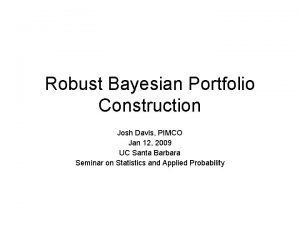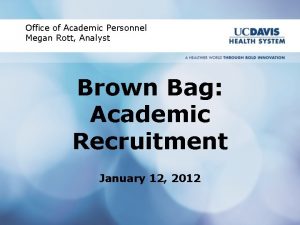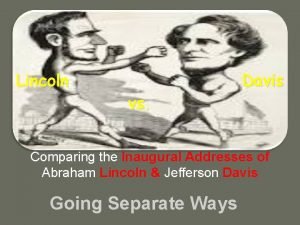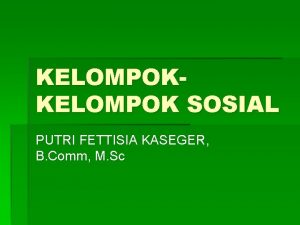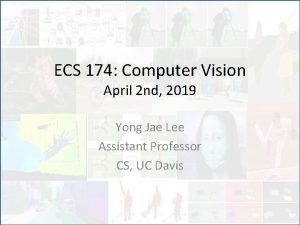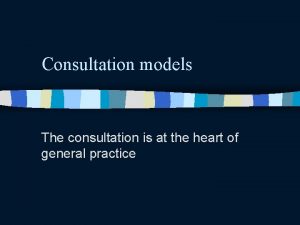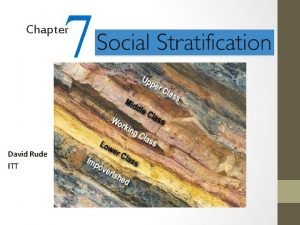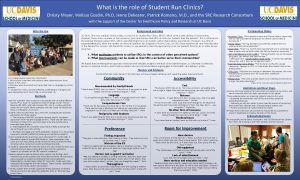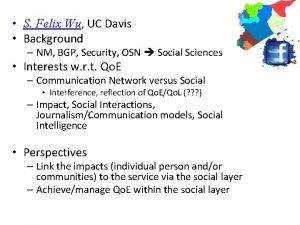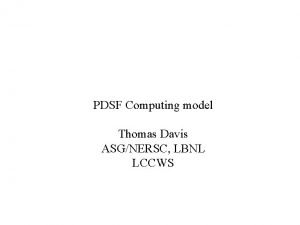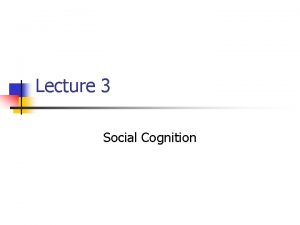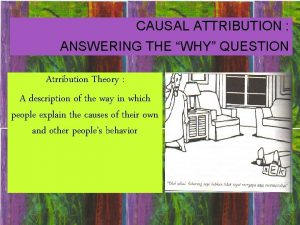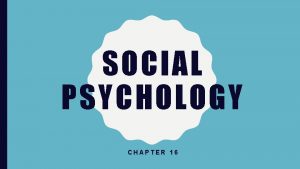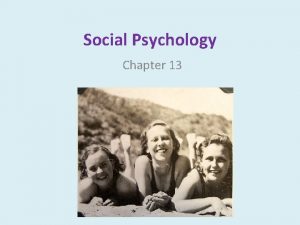Welcome to AP Psychology Mr Davis Chapter 14

































































- Slides: 65

Welcome to AP Psychology! Mr. Davis

Chapter 14 Social Psychology Copyright © Allyn & Bacon 2007

How Does the Social Situation Affect our Behavior? Situationism – The view that environmental conditions influence people’s behavior more than their personal dispositions do To what extent do you agree with situationism? Come put your initials on the continuum on the board. Copyright © Allyn & Bacon 2007

Experiment Grab a scrap of paper. It may be very small. You will only need to write a number on it. I do not want your name on it. Please put your head down and do not look at a clock. I am going to say “start, ” then later I will say “stop. ” When I am done, please estimate the time span. Do NOT confer with your neighbor. Now I will collect the estimates. Now I will ask you to do the same thing for another time span, but you do not need to write your answer. Just estimate it. Ready? Now I will ask you to give me your estimates out loud. Copyright © Allyn & Bacon 2007

Looking at the board, do you think social pressures may have caused some people to change where they put their initials? Let’s look at social psychology in action: Copyright © Allyn & Bacon 2007

How Does the Social Situation Affect our Behavior? We usually adapt our behavior to the demands of the social situation, and in ambiguous situations we take our cues from the behavior of others in that setting Copyright © Allyn & Bacon 2007

Attribution Scale – Handout 14 -2 Take the attribution scale quiz. Take it twice. First, fill it out to describe one of your parents, siblings, or someone else you know. Then turn it over and fill it out for yourself. When you are done, count how many “depends on the situation” you have for each person Who has more? You or the other person? If you have more for yourself than you do for the other person, you may have just fallen victim to the fundamental attribution error. Copyright © Allyn & Bacon 2007

Making Cognitive Attributions Question: When someone cuts you off in traffic, what is your first explanation for their behavior? Is he a bad driver, or was he temporarily distracted? Why do people fail tests? Are they dumb, or did they not study? Copyright © Allyn & Bacon 2007

Attribution—Assigning causes to behaviors Fundamental attribution error – Tendency to explain behavior by emphasizing internal causes and ignoring external causes (situational versus dispositional) Copyright © Allyn & Bacon 2007

Making Cognitive Attributions Self-serving bias – Attributional pattern in which one takes credit for success but denies responsibility for failure Success is dispositional but failure is situational Not everyone does this. But it is common enough to have its own term. Copyright © Allyn & Bacon 2007

Elaboration Likelihood Model Peripheral route persuasion: attitude change in which people are influenced by incidental cues, such as a speaker’s attractiveness (as opposed to central route persuasion) Foot-in-the-door phenomenon: tendency for those who have agreed to a small request to comply later with a larger request e. g. —How would you do this with your parents? Copyright © Allyn & Bacon 2007

Social Standards of Behavior Social role – Socially defined patterns of behavior that are expected of persons in a given social position In your notes, write down some of the different social roles you have. For instance, I am a teacher, a parent, a husband, a coach, a colleague, etc. , and each of those roles carries different, and often conflicting, expectations

Script – a sequence of events and actions expected in a particular setting (e. g. dating; meeting someone) – [every social role has different scripts] With your aisle partner, uncover a script you are expected to follow in one of your social roles. The script must be at least four steps long. Copyright © Allyn & Bacon 2007

Candid Camera Let’s watch the “Elevator” clip from Candid Camera. What is the subject’s social role? What script is the subject supposed to follow? How did the presence of other people affect behavior? How did interaction with others (or lack thereof) affect behavior? How did setting affect their behavior? What social norms were enforced or violated in these clips? In sum, how did the situation affect behavior? Now let’s watch the “Handsome Teacher” clip. Copyright © Allyn & Bacon 2007

Self-Justification How do you make someone actually enjoy a dull task? Overpay them for doing the task, or underpay? Here’s your answer Cognitive dissonance – Conflicting attitudes, beliefs or behaviors producing a feeling mental discomfort leading to a change in one of the attitudes, beliefs or behaviors to reduce the discomfort and restore balance In general, it’s easier to change beliefs than behavior (e. g. smoking) “We come to believe in, and to love, the things we have to suffer for. ” --Festinger Copyright © Allyn & Bacon 2007

Have you ever had a friend who was a jerk to other people, but was not a jerk to you? You had cognitive dissonance. Your belief (he’s a jerk) conflicted with your actions (he is your friend). Which is easier to change, your actions or your beliefs? Most of us choose to retain our actions (keep the friend) and change our beliefs (he’s not THAT bad of a guy). Copyright © Allyn & Bacon 2007

Conformity: Which line matches the line on the left? A Standard line 1 2 3 Comparison lines Copyright © Allyn & Bacon 2007

Conformity: The Asch studies What would you say if you were in a room full of people who all picked line number two? A Standard line 1 2 3 Comparison lines Copyright © Allyn & Bacon 2007

Correct answers (percent) Conformity No opposition (control) 100 With partner 80 60 Alone against majority 40 20 0 1 2 3 4 5 6 7 Critical trials 8 9 10 11 12 Copyright © Allyn & Bacon 2007

The Asch conformity experiment, introduced by Philip Zimbardo Copyright © Allyn & Bacon 2007

The conformity was due to… Normative social influence: influence resulting from a person’s desire to gain approval or avoid disapproval [e. g. Asch conformity experiment; the way many dress in HS] Informational social influence: influence resulting from one’s willingness to accept others’ opinions That is, expected behaviors (norms) are created by the people around us (social influence) Copyright © Allyn & Bacon 2007

Group Characteristics That are Likely to Affect Conformity • The size of the majority • The presence of a partner who dissented from the majority • The size of the discrepancy between the correct answer and the majority position Copyright © Allyn & Bacon 2007

Social Standards of Behavior Social norms – A group’s expectations regarding what is appropriate and acceptable behavior Social norms influence students’ political views (e. g. college campus) Copyright © Allyn & Bacon 2007

Examples of norms Walking on the right side of the sidewalk. Tipping. Saying thank you. What else? Discuss with your aisle partner. Copyright © Allyn & Bacon 2007

Discuss the following with your aisle partner: Think of a situation where… 1. A particular person or group might affect your behavior 2. A particular activity might alter your behavior 3. A particular setting might affect your behavior 4. Different expectations or social norms might affect your behavior Write your answers in your notes so you can remember them, and be prepared to share

Milgram and Obedience to Authority Imagine if an experimenter studying “the effects of punishment on memory” asked you to deliver painful electric shocks to a a middle-aged man who had been treated for a heart condition Each time the man missed an answer, you would be instructed to deliver an increasingly powerful shock Copyright © Allyn & Bacon 2007

Milgram’s Shock Generator Caution On Amp Meter Amps Slight Shock Moderate Shock Intensity Strong Shock Resistance Very Strong Shock Intense Shock Extreme Shock Danger XXX Would you deliver a “Moderate Shock? ” Copyright © Allyn & Bacon 2007

Milgram’s Shock Generator Caution On Amp Meter Amps Slight Shock Moderate Shock Intensity Strong Shock Resistance Very Strong Shock Intense Shock Extreme Shock Danger XXX Would you refuse the experimenter’s instruction to deliver an “Extreme Shock? ” Copyright © Allyn & Bacon 2007

Milgram’s Shock Generator Caution On Amp Meter Amps Slight Shock Moderate Shock Intensity Strong Shock Resistance Very Strong Shock Intense Shock Extreme Shock Danger XXX What if the victim was screaming in agony? Copyright © Allyn & Bacon 2007

Milgram’s Shock Generator Caution On Amp Meter Amps Slight Shock Moderate Shock Intensity Strong Shock Resistance Very Strong Shock Intense Shock Extreme Shock Danger XXX Two thirds of participants delivered the maximum 450 volts to the learner Copyright © Allyn & Bacon 2007

Obedience to Authority In Milgram’s experiment The victim was an actor The victim received no actual shocks This experiment demonstrated the powerful effects of obedience to authority. Situational factors, more than personality variables, appeared to affect people’s levels of obedience Copyright © Allyn & Bacon 2007

The Milgram Experiment Copyright © Allyn & Bacon 2007

Milgram’s Eight Steps Toward Conformity -Getting Good People to Harm Others 1. Provide people with an ideology to justify beliefs for actions 2. Make people take a small first step toward a harmful act with a minor, trivial action and then gradually increase those small actions. A. k. a. the foot-in-the-door phenomenon 3. Make those in charge seem like a “just authority” 4. Provide people with vague and ever changing rules Copyright © Allyn & Bacon 2007

Milgram’s Eight Steps Toward Conformity -Getting Good People to Harm Others 5. Provide people with social models of compliance 6. Allow verbal dissent but only if people continue to comply behaviorally with orders 7. Encourage dehumanizing the victim 8. Make exiting the situation difficult Copyright © Allyn & Bacon 2007

The Milgram Experiment rethought…(skip to 10: 55) As you listen to the 14 minute radio program, we are going to do an experiment. Don’t take “notes”. Get messy! Concentrate and doodle the entire time, trying to capture as much information as you can in a non-linear way. I will see what you remember based on your doodle on Thursday. Copyright © Allyn & Bacon 2007

Other Topics in Social Psychology Social facilitation – An increase in performance because of being in (or observed by) a group [e. g. home games] Social loafing – A decrease in performance because of being in a group [e. g. group projects] Copyright © Allyn & Bacon 2007

Question Get out a half (or quarter) sheet of paper and DO NOT put your name on it. This MUST be anonymous. If you could do anything humanly possible with complete assurance that you would not be detected or held responsible, what would you do? In asking you the question, I have taken away your identity and your responsibility for your behavior. This concept is called. . . Deindividuation Copyright © Allyn & Bacon 2007

Deindividuation: the loss of personal individuality and responsibility because you feel more anonymous [often in a crowd] (internet trolling; masquerade balls; Among the Thugs) Copyright © Allyn & Bacon 2007

Cohesiveness resulted in… Group polarization – When people in a group have similar, though not identical, views, their opinions become more extreme What are some differences between group polarization and groupthink? Discuss with your aisle partner Copyright © Allyn & Bacon 2007

The Robbers’ Cave: An Experiment in Conflict Cooperation replaced conflict when the experimenters contrived situations that fostered mutual interdependence and common (superordinate) goals for the groups Mutual interdependence – Shared sense that people need each other in order to achieve common goals Copyright © Allyn & Bacon 2007

Groupthink The desire for harmony in a group results in an irrational decision. Group members agree without evaluating alternative viewpoints, by suppressing dissenting viewpoints, and isolating themselves from outside influences. Examples of groupthink: Bay of Pigs; Vietnam; Challenger disaster Question with your aisle partner—what is the difference between conformity and groupthink? Groupthink may also be caused by the false consensus effect: the tendency to overestimate the extent to which their opinions, beliefs, and habits are typical of those of others Copyright © Allyn & Bacon 2007

Causes of Groupthink Conditions likely to promote groupthink include: • • Isolation of the group High group cohesiveness Authoritarian leadership Similarity of members’ social background and ideology • High stress from external threats • Lack of norms for making decisions – allows for arbitrary decisions A Democratic or Republican caucus meeting could fulfill all these criteria (except maybe the last one) Copyright © Allyn & Bacon 2007

Prejudice and Discrimination Prejudice – A negative attitude toward people based solely on their membership in a particular group Discrimination – A negative action taken against people as a result of their group membership Copyright © Allyn & Bacon 2007

Prejudice and Discrimination In-group – The group with which an individual identifies Out-group – Those outside the group with which an individual does not identify Social distance – The perceived difference between oneself and another person (e. g. other-race effect—tendency to recognize faces of own race) Copyright © Allyn & Bacon 2007

Causes of Prejudice Dissimilarity and Social Distance Copyright © Allyn & Bacon 2007

Causes of Prejudice Dissimilarity and Social Distance Economic Competition -The U. S. often blames immigrants (Irish, Chinese, Mexican) for our economic problems. -- “They’re taking our jobs!” -Studies show that the number of lynchings in the south rose with economic difficulties and fell with prosperity. Copyright © Allyn & Bacon 2007

Causes of Prejudice Dissimilarity and Social Distance Economic Competition Scapegoating -prejudice offers an outlet for anger by providing someone to blame: -Nazi Germany blamed Jews for economic problems. Copyright © Allyn & Bacon 2007

Causes of Prejudice Dissimilarity and Social Distance Economic Competition Scapegoating Conformity to Social Norms -Fat shaming -Different regions of the country Copyright © Allyn & Bacon 2007

Causes of Prejudice Dissimilarity and Social Distance Economic Competition Scapegoating Conformity to Social Norms Media Stereotypes Copyright © Allyn & Bacon 2007

How easy is it to create, or stop, prejudice? Observe the experiment one third grade the experiment teacher in Iowa conducted on her class. Apply the following terms to the experiment(s) Cognitive Dissonance In-group Prejudice Out-group Discrimination Social distance Scapegoating FAE Conformity to social norms Self-fulfilling prophecy Copyright © Allyn & Bacon 2007

Combating Prejudice Research suggests that the possible tools for combating prejudice include: New role models Equal status contact Superordinate goals Legislation Copyright © Allyn & Bacon 2007

Aggression Frustration-aggression principle: aggression is the result of blocking a person's efforts to attain a goal Copyright © Allyn & Bacon 2007

Some behavior can be explained by… The Just-World Hypothesis: the belief that • actions always bring fair consequences, • noble actions are rewarded and evil actions are punished. • consequences are the result of a higher universal power that restores moral balance. • Do “Just World Scale” 14 -11 Copyright © Allyn & Bacon 2007

Higher scores= JWS More favorable attitudes toward Congress, the Supreme Court, the military and business. You might believe more in others’ sincerity, in God an internal locus of control. You might believe illness is a result of not taking care of yourself, rather than attributing it to bad luck You might take more responsibility for your setbacks (poor test scores, lack of playing time), and assume that others are responsible for their own setbacks. You might actually be MORE likely to help the less fortunate if that help is likely to fix the problem. You also MAY have been more likely to shock learners. Copyright © Allyn & Bacon 2007

Shifting Gears from bad…to good What are the main reasons we are attracted to a friend or a mate? Discuss with your aisle partner 1. Physical attractiveness: duh… 2. Proximity: it’s amazing how often our “soul mate” goes to our school 3. Similarity: especially of social backgrounds 4. Self-disclosure: we like people who share their inmost thoughts, and those who listen to ours 5. Equity: giving & receiving in equal proportion Copyright © Allyn & Bacon 2007

Attraction Mere exposure effect: repeated exposure to a novel stimuli increases liking of them Halo effect: the tendency for an impression created in one area to influence opinions in other areas (e. g. beautiful people often get the benefit of the doubt) Copyright © Allyn & Bacon 2007

Interpersonal Attraction Reward theory/expectancy-value theory we like best those who give us maximum rewards at minimum cost Matching hypothesis – Prediction that most people will find friends and mates that are about their same level of attractiveness (mismatch? ) Copyright © Allyn & Bacon 2007

Sternberg’s Triangular Theory of Love Infatuation Passion Romantic love Intimacy Stalking Commitment Friendship Copyright © Allyn & Bacon 2007

Copyright © Allyn & Bacon 2007

The Bystander Problem Altruism – unselfish regard for the welfare of others Bystander effect – tendency for a bystander to be less likely to give aid if other bystanders are present (diffusion of responsibility) Turn to an aisle partner: what’s the difference between deindividuation and diffusion of responsibility? Copyright © Allyn & Bacon 2007

Conflict, peacemaking, and GRIT Social exchange theory: our social behavior is an exchange process, the aim of which is to maximize benefits and minimize costs Reciprocity norm: an expectation that people will help norm those who have helped them. [e. g. free mailing labels; free samples; time share presentations] Social trap: a situation in which conflicting parties, by each rationally pursuing their self-interest, become caught in mutually destructive behavior. [e. g. the Cold War] A. k. a. tragedy of the commons Social responsibility norm: an expectation that people will help those needing their help Mirror image perceptions: mutual views held by conflicting people, as when each side sees itself as ethical and peaceful and views the other side as evil & aggressive Copyright © Allyn & Bacon 2007

As we watch the video, apply the following video concepts to the Stanford Prison experiment: 1. Social roles 2. Scripts 3. Normative social influence 4. Groupthink 5. The Just World Hypothesis 6. The Bystander Problem 7. Deindividuation Copyright © Allyn & Bacon 2007

GRIT Graduated and Reciprocated Initiatives in Tension Reduction 1. Find mutual interests 2. Announce intent to reduce tensions 3. Initiate small conciliatory acts Copyright © Allyn & Bacon 2007

Social Psychology Social psychology – studies the effects of social context on individual behavior Social context – The combination of (a) The activities and interactions among people (b) The setting in which behavior occurs, and (c) Social norms governing behavior in that setting Copyright © Allyn & Bacon 2007

End of Chapter 14 A final plea: don’t let social factors stop you from doing the right thing A Crash Course review of some social psychology terms Copyright © Allyn & Bacon 2007
 Groupthink vs group polarization
Groupthink vs group polarization Wise men three clever are we
Wise men three clever are we Positive psychology ap psychology definition
Positive psychology ap psychology definition Social psychology ap psychology
Social psychology ap psychology Introspection psychology
Introspection psychology Social psychology is the scientific study of:
Social psychology is the scientific study of: Health psychology definition ap psychology
Health psychology definition ap psychology Leila g davis
Leila g davis Aggie advising college of biological sciences
Aggie advising college of biological sciences Fluvial cycle of erosion by davis and penck
Fluvial cycle of erosion by davis and penck Uc davis admissions portal
Uc davis admissions portal Ellis and davis classification
Ellis and davis classification W.m. davis
W.m. davis Teresa davis ttu
Teresa davis ttu Hester davis falls risk assessment scale
Hester davis falls risk assessment scale Uc davis siss advisor
Uc davis siss advisor Josh davis pimco
Josh davis pimco Planos de la cavidad abdominal
Planos de la cavidad abdominal Miv uc davis
Miv uc davis Dessolene davis
Dessolene davis Lincoln vs davis inaugural address
Lincoln vs davis inaugural address Kerumunan menurut kingsley davis
Kerumunan menurut kingsley davis Elompok
Elompok Kerumunan menurut kingsley davis
Kerumunan menurut kingsley davis Hoopy portal
Hoopy portal Uc davis benefits
Uc davis benefits Functionalist views on education
Functionalist views on education Ecs 174 uc davis
Ecs 174 uc davis Appendesectomy
Appendesectomy Davisware
Davisware Payroll davis school district
Payroll davis school district Davis and moore 1945
Davis and moore 1945 Davis drive middle
Davis drive middle Davis drive middle school electives
Davis drive middle school electives Cyclotron operator
Cyclotron operator Eric prebys
Eric prebys Stott and davis model
Stott and davis model Neighbours model of consultation
Neighbours model of consultation Forester miller and davis model
Forester miller and davis model 4 stages of appendicitis
4 stages of appendicitis Rockey davis incision
Rockey davis incision Fermilab
Fermilab Rocky davis incision
Rocky davis incision Karl marx conflict theory
Karl marx conflict theory Miles davis magnet academy
Miles davis magnet academy Cover letter uc davis
Cover letter uc davis Student run clinics uc davis
Student run clinics uc davis Who killed shamari davis
Who killed shamari davis Ucdavis irb
Ucdavis irb Temple operating system
Temple operating system S wu uc davis
S wu uc davis Stuart davis
Stuart davis Thomas davis model
Thomas davis model Desirae davis
Desirae davis Jones and davis attribution theory
Jones and davis attribution theory Kuali uc davis
Kuali uc davis Davis slope decline theory
Davis slope decline theory Howard zhang davis polk
Howard zhang davis polk Davis school district payroll
Davis school district payroll Ecs 129
Ecs 129 Atrribution
Atrribution Dr tanya davis
Dr tanya davis Frs uc davis
Frs uc davis Charlie davis motors
Charlie davis motors Correspondent inference theory
Correspondent inference theory Train resistance formula
Train resistance formula
















